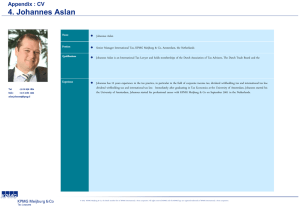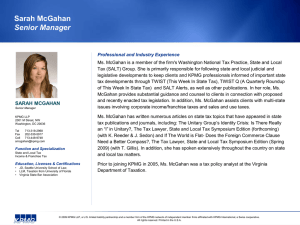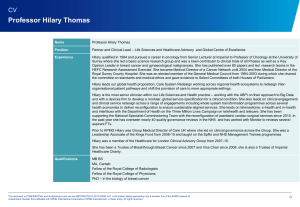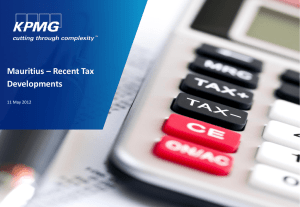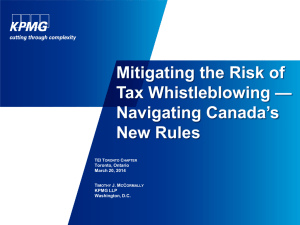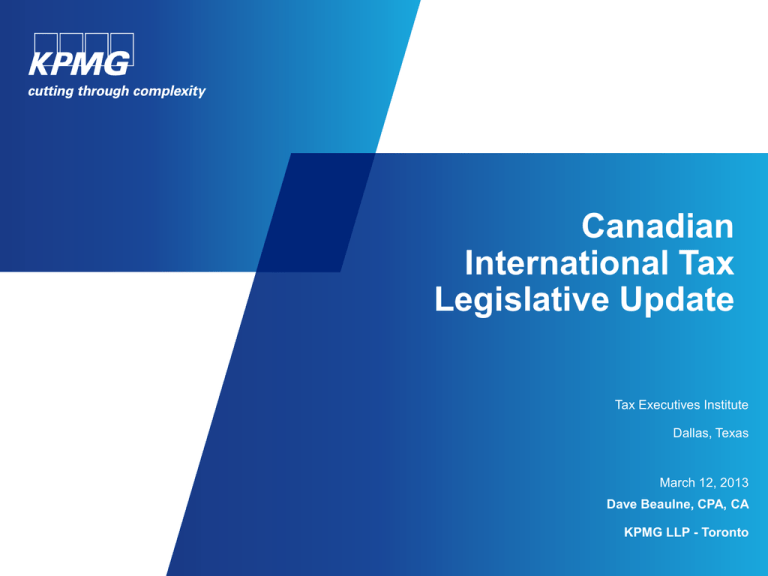
Canadian
International Tax
Legislative Update
Tax Executives Institute
Dallas, Texas
March 12, 2013
Dave Beaulne, CPA, CA
KPMG LLP - Toronto
Agenda
1. Background on Canadian tax
2. Inbound (investment into Canada) developments:
a) Pertinent loans or indebtedness (PLOIs)
b) Thin capitalization amendments
c) Foreign affiliate dumping
3. Transfer pricing
4. Outbound (Canadian investment abroad) developments
5. Tax treaty developments
© 2013 KPMG LLP, a Canadian limited liability partnership and a member firm of the KPMG network of independent member firms affiliated with
KPMG International Cooperative (“KPMG International”), a Swiss entity. All rights reserved.
2
1. Background on Canadian
tax
Background on Canadian tax
Federal/provincial corporate tax rates
• Federal tax rate is 15%
• Provincial tax rates range from 10% to 16%, but the big 4 (B.C.,
Alta, Qc and Ont) are in the 10% to 12% range
PUC (paid-up capital)
• Distributions from a Canadian corporation to its foreign parent
can be in the form of dividends (generally subject to 5% WHT) or
a return of PUC (which is free of WHT)
Exemption system
• Dividends from a foreign subsidiary to its Canadian parent are
generally exempt (no regard to level of foreign tax) if the income
is from an active business carried on in a country with which
Canada has an income tax convention (treaty) or a tax
information exchange agreement (TIEA)
© 2013 KPMG LLP, a Canadian limited liability partnership and a member firm of the KPMG network of independent member firms affiliated with
KPMG International Cooperative (“KPMG International”), a Swiss entity. All rights reserved.
4
Background on Canadian tax
Interest expense
• No general restrictions on interest paid on borrowings used to acquire
foreign subsidiaries (referred to as “foreign affiliates”), notwithstanding
that income therefrom may be exempt
• Thin capitalization rules restrict interest expense solely based on identity
of lender (generally related non-residents) and level of debt and equity in
the company
Constructive dividends
• Loans by a Canadian subsidiary to its foreign parent (or non-resident
persons related to the parent) are treated as constructive dividends
(subject to 5% WHT) if left outstanding for, roughly, 1.5 years
• 5% WHT is refundable upon repayment, unless part of a series of
loans and repayments
• Loans by a foreign subsidiary of a Canadian corporation (referred to as
“upstream loans”) to the Canadian parent or a foreign grand-parent are
also treated as constructive dividends in certain circumstances
© 2013 KPMG LLP, a Canadian limited liability partnership and a member firm of the KPMG network of independent member firms affiliated with
KPMG International Cooperative (“KPMG International”), a Swiss entity. All rights reserved.
5
Background on Canadian tax
Treaty policy
• Dividend WHT: 5% and 15%
• Interest WHT: 10% N-A-L; 0 A-L (under domestic law)
• one exception: U.S.
• Royalty WHT: 0 on patents and know how; 10% on others
Taxable Canadian property
• Non-residents of Canada taxable on gains only if TCP
• real estate and resource property
• shares that derive more than 50% of value from RE and RP
© 2013 KPMG LLP, a Canadian limited liability partnership and a member firm of the KPMG network of independent member firms affiliated with
KPMG International Cooperative (“KPMG International”), a Swiss entity. All rights reserved.
6
2. Inbound developments
Pertinent loans or indebtedness (PLOIs)
PLOIs
• HUGE relieving change for loans from a Canadian corporation
to its foreign parent (or other related foreign persons)
• Provides an elective exclusion from the constructive dividend
rules at the cost of imputed interest at a prescribed rate
USCo
Loan 1
Germany
Canco
© 2013 KPMG LLP, a Canadian limited liability partnership and a member firm of the KPMG network of independent member firms affiliated with
KPMG International Cooperative (“KPMG International”), a Swiss entity. All rights reserved.
Loan 2
8
PLOIs
Constructive dividend rules
• In the absence of a PLOI election, Loans 1 and 2 are deemed to be dividends paid to U.S.
parent and German subsidiary, respectively, if they remain outstanding beyond the end of the
taxation year following the year in which the loan is made (on average, 1.5 years)
• Dividend WHT of 5% on Loan 1 and 15% on Loan 2
• Upon repayment of the loans, WHT is refundable, unless the repayment is part of a “series of
loans and repayments”
PLOI election
• Constructive dividend rule N/A
• Canadian corporation must include interest of at least a prescribed rate in its income
• Currently the rate is approx. 5% (1% gov't bond rate plus 4%)
• Higher rate required if funding rule applies
• No refundability of taxes upon repayment
© 2013 KPMG LLP, a Canadian limited liability partnership and a member firm of the KPMG network of independent member firms affiliated with
KPMG International Cooperative (“KPMG International”), a Swiss entity. All rights reserved.
9
9
PLOIs
Conditions for application
• Loan must come from a Canadian corporation (CRIC)
• Loan must be received by a foreign corporation
• CRIC must be controlled by the borrower, or by a foreign corporation that is related
to the borrower
• Loan must be made after March 28, 2012
• Election required, on a loan by loan basis, on or before CRIC’s FDD for year of
loan (June 30th for a calendar year CRIC)
• Additional rules deal with partnerships, late-filed elections and mergers
© 2013 KPMG LLP, a Canadian limited liability partnership and a member firm of the KPMG network of independent member firms affiliated with
KPMG International Cooperative (“KPMG International”), a Swiss entity. All rights reserved.
10
10
PLOI – imputed interest
• Interest imputed to the extent prescribed rate exceeds actual interest rate
• example:
• prescribed rate is 5%;
• actual interest rate on loan is 2%;
• therefore, CRIC must include another 3% in income
• Creates an incentive to set actual rate equal to PR
• However, if interest is adjusted downward under competent authority request, PLOI
election is invalidated
• If PLOI is funded by a borrowing by the CRIC and the rate on the borrowing is
higher than PR, CRIC must include in income an amount equal to interest expense
on borrowing
© 2013 KPMG LLP, a Canadian limited liability partnership and a member firm of the KPMG network of independent member firms affiliated with
KPMG International Cooperative (“KPMG International”), a Swiss entity. All rights reserved.
11
11
PLOI election – perspective
• Avoids WHT on constructive dividend
• But, not a permanent tax: WHT is refundable when loan is repaid
• total Canadian tax paid over time (under PLOI election) may well exceed 5% WHT
on constructive dividend, and creates greater amount of cash “trapped” in Canada
• key is to recover the Canadian tax on PLOI with a deduction in the U.S.
• risk that PLOI rate is higher than arm’s length rate
• foreign revenue authority (IRS) could make transfer pricing downward adjustment
on PLOI interest rate;
• can’t recover under MAP
© 2013 KPMG LLP, a Canadian limited liability partnership and a member firm of the KPMG network of independent member firms affiliated with
KPMG International Cooperative (“KPMG International”), a Swiss entity. All rights reserved.
12
12
PLOI election – transitional issues
• PLOI election applies to loans made after March 28, 2012
• What about loans made before?
• Can a refund of WHT be obtained for repayment of old loans, with PLOI rules
applying to a new post-March 28th loan?
• Initial policy views from Canadian gov’t not favourable
• However, still a technical avenue:
• Constructive dividend rule has a “series of loans and repayments” prohibition
• Does a single repayment, followed by a new post-March 28th loan fall afoul?
• Representations continue to be made on this: stay tuned …
© 2013 KPMG LLP, a Canadian limited liability partnership and a member firm of the KPMG network of independent member firms affiliated with
KPMG International Cooperative (“KPMG International”), a Swiss entity. All rights reserved.
13
13
Thin Capitalization
• March 29, 2012 Budget made a number of changes
• Debt-to-equity ratio reduced to 1.5:1 (from 2:1)
• interest is denied to the extent the ratio is exceeded
• equity is R/E and cross-border PUC/contributed surplus
• debt is only that lent by specified NR (generally related NR)
• guaranteed debt and domestic tax exempts not included
• Denied interest now recharacterized as a dividend for WHT purposes
• thin cap results in permanent denial of interest: no c/fwds – thus, notionally
treated as a dividend
• interest WHT was still levied on denied amounts
• Fifth Protocol with U.S. in 2007 eliminated (on a phased-in basis) interest WHT
on related party interest – created a planning opportunity for denied interest
© 2013 KPMG LLP, a Canadian limited liability partnership and a member firm of the KPMG network of independent member firms affiliated with
KPMG International Cooperative (“KPMG International”), a Swiss entity. All rights reserved.
14
14
Thin Capitalization
• Thin capitalization rules now extended to partnerships that borrow from specified
NRs (where partnership has Canadian-resident members)
• rule operates on a look-through basis: partnership’s debt allocated to its
members based on its proportionate share of the income or loss of the
partnership
• Relieving change made for loans from a foreign subsidiary to its Canadian parent
• in certain corporate structures “upstream loans” could cause double tax:
• interest paid by Canco denied under thin cap
• interest received by foreign sub included in Canco’s income under FAPI (CFC
rules)
• new rule turns off thin cap to the extent of FAPI
© 2013 KPMG LLP, a Canadian limited liability partnership and a member firm of the KPMG network of independent member firms affiliated with
KPMG International Cooperative (“KPMG International”), a Swiss entity. All rights reserved.
15
15
Thin Capitalization
Future possible changes?
• trusts
• branches
• guaranteed debt
• broad-based reform (as in Australia, Germany)
© 2013 KPMG LLP, a Canadian limited liability partnership and a member firm of the KPMG network of independent member firms affiliated with
KPMG International Cooperative (“KPMG International”), a Swiss entity. All rights reserved.
16
16
Evolution of the Foreign Affiliate Dumping rules
Interest deductibility
■ June 1971 Budget: removed the denial of interest to a Canadian corporation on funds borrowed to acquire
shares of another corporation (domestic or foreign)
■ AG report in 1992 was critical of this policy re: FAs
■ 1997 Mintz Report recommended broad-based interest restrictions
■ AG report in 2002 reiterated its previous criticism, most particularly with respect to foreign-controlled
Canadian companies
■ March 2007 Budget adopted, in most respects, the Mintz Report proposals
– interest on borrowed money used to acquire shares of FAs would be denied (unless and until taxable
amounts were received)
■ Heavy backlash led to a watered-down proposal in May 2007 which targeted double dip interest –
proposal was to be effective starting in 2012
– As part of the May 2007 proposals the Minister of Finance re-iterated his March 2007 proposal to
create an Advisory Panel that would study, among other things, thin cap reform and “debt dumping”,
which many said was the real problem with interest deductibility
© 2013 KPMG LLP, a Canadian limited liability partnership and a member firm of the KPMG network of independent member firms affiliated with
KPMG International Cooperative (“KPMG International”), a Swiss entity. All rights reserved.
17
Evolution of the Foreign Affiliate Dumping rules
Interest deductibility (cont’d)
■ December 2008 Advisory Panel issued its Final Report which recommended, among other
things, the repeal of the “double dip” rule
■ January 2009 Budget took up the Panel’s recommendation and repealed the double dip
rule (which wasn’t even in effect yet)
■ March 2012 Budget introduced Foreign Affiliate Dumping rules (and made some
amendments to the thin cap rules)
– FA-D is a deemed dividend rule, not an interest denial rule, but one its key objectives is
to deter “debt dumping”
– deemed dividend approach helps deal with “tracing” problems
– rules allow access to treaty-reduced dividend WHT rates, which allows cost to be
reduced to 5% - thus, could still be worthwhile
– BUT: Budget comments contain a warning that if FA-D continues, additional steps could
be taken
© 2013 KPMG LLP, a Canadian limited liability partnership and a member firm of the KPMG network of independent member firms affiliated with
KPMG International Cooperative (“KPMG International”), a Swiss entity. All rights reserved.
18
Foreign Affiliate Dumping – big picture
The perceived abuse
■ Foreign companies eroding the tax base by selling FAs to Canadian subs in
exchange for debt – interest deductible but dividends exempt (debt dumping)
■ Foreign companies avoiding dividend WHT by having Canadian subs transfer
excess cash through purchase of FAs - again, no likely taxation of the
investment in the FA
– Both aspects use the FA exemption system to achieve Canadian tax benefits
Solution: deemed dividend to extent of purchase price
■ For WHT avoidance, puts taxpayers in same position
■ For "debt dumping", acts as a deterrent
– question as to whether 5% is enough to deter (AP didn’t think so)
© 2013 KPMG LLP, a Canadian limited liability partnership and a member firm of the KPMG network of independent member firms affiliated with
KPMG International Cooperative (“KPMG International”), a Swiss entity. All rights reserved.
19
Foreign Affiliate Dumping – targeted transactions
New $10M
Interest Bearing
Debt
US Parent
Equity $5M
UK Co
Canco
FMV = $15M
UKCo
• US Parent contributes shares of
UKCo to Canco in exchange for
debt of $10M and $5M of Canco
shares;
• Canco’s thin cap attributes (PUC)
increase by $5M, which allows full
interest deduction on increased
debt of $10M (based on pre-2012
2 to 1 ratio);
• UKCo is now an FA of Canco, and
dividends can be distributed to
Canco tax free;
• alternatively, Canco could pay
with excess cash, thereby
avoiding 5% dividend WHT.
© 2013 KPMG LLP, a Canadian limited liability partnership and a member firm of the KPMG network of independent member firms affiliated with
KPMG International Cooperative (“KPMG International”), a Swiss entity. All rights reserved.
20
20
Foreign Affiliate Dumping – conditions
Conditions for application of rules
■ Canadian resident corporation (CRIC) is controlled by a non-resident corporation
■ CRIC makes an “investment” in a foreign affiliate (FA)
“Investment” includes
■ Acquisition of shares of FA (whether from A-L or N-A-L party)
■ Indirect acquisitions: acquisition of Canco if loaded with FAs (> 75%)
■ Loans from CRIC to FA
– Excludes certain debt arising in ordinary course of CRIC’s business
– Excludes “pertinent loans or indebtedness” (PLOIs)
■ Other variations: acquisition of debt, extension of maturity date, capital contributions
© 2013 KPMG LLP, a Canadian limited liability partnership and a member firm of the KPMG network of independent member firms affiliated with
KPMG International Cooperative (“KPMG International”), a Swiss entity. All rights reserved.
21
Foreign Affiliate Dumping – indirect acquisitions
Indirect investment in FA
■ Direct acquisition by CRIC of shares of a Canadian corporation that owns a FA
■ At least 75% of Canadian corporation’s value is attributable to FA shares
NR
Parent
CRIC =>
Can
Acq Co
Can
Target
>75% of value
FA
© 2013 KPMG LLP, a Canadian limited liability partnership and a member firm of the KPMG network of independent member firms affiliated with
KPMG International Cooperative (“KPMG International”), a Swiss entity. All rights reserved.
22
Foreign Affiliate Dumping – consequences
Results of application of FA-D rules
■ Deemed dividend equal to value of property transferred by CRIC, or debt assumed by
CRIC, in respect of the investment in FA
– default rule: dividend deemed paid by CRIC to non-resident parent
– special rules facilitate access to 5% WHT rate
– dividend reduced to extent of CRIC’s cross-border PUC
Related rules
■ PUC suppression
■ Contributed surplus suppression
■ Immigration
■ Emigration
© 2013 KPMG LLP, a Canadian limited liability partnership and a member firm of the KPMG network of independent member firms affiliated with
KPMG International Cooperative (“KPMG International”), a Swiss entity. All rights reserved.
23
Foreign Affiliate Dumping – exceptions / relief
Closer connection exception
■ Business activities of FA must be more closely connected to business activities of CRIC
than to business activities of other non-resident group members
■ Meant for CRICs that are acting like a true MNC, i.e. it would have made the purchase if it
were not controlled by NR
“Pertinent loan or indebtedness” (PLOI) election
■ Generally results in imputed income inclusion equal to unrounded prescribed rate plus 4%
Certain reorganizations exempted
■ Internal reorganizations that could otherwise result in an acquisition of FA shares by a
CRIC
PUC reinstatement
■ Allows unwind of FA investment where CRIC used as holding company
© 2013 KPMG LLP, a Canadian limited liability partnership and a member firm of the KPMG network of independent member firms affiliated with
KPMG International Cooperative (“KPMG International”), a Swiss entity. All rights reserved.
24
Foreign Affiliate Dumping – take aways
■ If Canco is controlled by a non-resident corporation, rules must be top-of-mind
when Canco has existing investments in foreign affiliates or is contemplating a
new FA acquisition
■ Be wary of transactions that routinely occur, such as cash movements in cash
pooling arrangements that involve foreign affiliates and Canada
■ Reconsider cash management strategy where Canada accumulates excess cash
which has historically been used to fund foreign affiliates
■ All is not lost – 5% toll charge may still lead to long term benefits (especially if
interest rates rise)
– But, keep in mind government’s warning of possible future action
© 2013 KPMG LLP, a Canadian limited liability partnership and a member firm of the KPMG network of independent member firms affiliated with
KPMG International Cooperative (“KPMG International”), a Swiss entity. All rights reserved.
25
Foreign Affiliate Dumping – collateral damage?
• Pre-FA Dumping, NewCanco could
US Parent
PUC = $100
USco
NewCanco
Canco
USco
FMV = $100
PUC = $1
Canco
acquire shares of USco from US Parent in
consideration for NewCanco shares with
PUC of $100; USco would then liquidate
• FA Dumping now grinds PUC of
NewCanco shares to nil (because
purchase of USco is an investment in a FA
made by a CRIC)
• Workarounds exist, but must consider
GAAR
• Was this structure intended to be
caught? What does the extrinsic
evidence suggest?
© 2013 KPMG LLP, a Canadian limited liability partnership and a member firm of the KPMG network of independent member firms affiliated with
KPMG International Cooperative (“KPMG International”), a Swiss entity. All rights reserved.
26
26
3.Transfer pricing
Transfer pricing: secondary adjustments
Transfer pricing “primary” adjustments
generally adjust income for incorrect
pricing
Secondary adjustments are intended to
account for the “excess” funds that
have been transferred out of the
Canadian tax system
USCo
Deemed
dividend: to
USCo or
Forco?
ForCo
Budget 2012 introduced specific
legislation to codify CRA practice
deemed dividend to foreign person
with which transaction carried out
Canco
Overpayment for
purchases;
underpayment for
sales
clarifies which treaty to apply
where foreign person is not a
shareholder, 5% WHT n/a
repatriation relief, but subject to
discretion of CRA
no application to CFAs
© 2013 KPMG LLP, a Canadian limited liability partnership and a member firm of the KPMG network of independent member firms affiliated with
KPMG International Cooperative (“KPMG International”), a Swiss entity. All rights reserved.
28
4.Outbound developments
Outbound developments
TTAA / Bill C-48
■ very large tax bill
■ NWMM on October 24, 2012
■ November 21, 2012: first reading in the House of Commons
■ Part 1 deals with non-resident trusts and offshore investment
funds
■ Part 2 covers the December 18, 2009 foreign affiliate proposals
■ Part 3 covers the August 19, 2011 foreign affiliate proposals
(including hybrid surplus and upstream loans)
■ Part 5 includes the foreign tax credit generator rules and various
long-outstanding technical amendments
© 2013 KPMG LLP, a Canadian limited liability partnership and a member firm of the KPMG network of independent member firms affiliated with
KPMG International Cooperative (“KPMG International”), a Swiss entity. All rights reserved.
30
Outbound developments
Hybrid surplus
•
new surplus account to ensure capital gains on dispositions of FA
shares are properly taxed when any part of proceeds distributed to
Canada
•
also ensures no creation of phantom exempt surplus
•
no new developments, but now fully phased-in (as of 2013)
Foreign tax credit generators
•
hybrid instruments anti-avoidance rule
•
denies FTC where Canada and foreign jurisdiction (most commonly
U.S.) view investment differently (such as repos)
•
in FA context, any FAPI earned in a chain of companies that has a
hybrid instrument will not be eligible for FTC
•
tainting was broader in pre-October 24, 2012 version of rules
© 2013 KPMG LLP, a Canadian limited liability partnership and a member firm of the KPMG network of independent member firms affiliated with
KPMG International Cooperative (“KPMG International”), a Swiss entity. All rights reserved.
31
Outbound developments
Upstream loans
•
ensures Canadian taxpayers cannot avoid dividend tax on distributions
from FAs by instead having FAs make loans (where insufficient basis
and exempt surplus)
•
if loan not repaid within 2 years, full principal amount included in
income
•
deduction to the extent of repayment
•
October 24, 2012 re-release provides some relief, including:
•
pre-August 19, 2011 loans now have 5 year repayment deadline;
•
FX gain/loss offset for pre-August 19th loans
© 2013 KPMG LLP, a Canadian limited liability partnership and a member firm of the KPMG network of independent member firms affiliated with
KPMG International Cooperative (“KPMG International”), a Swiss entity. All rights reserved.
32
Outbound developments – upstream loans example
• if Canco paid a dividend to USco, dividend would attract 5%
Canadian dividend withholding tax;
USCo
• thus, Canco could form FA and contribute its excess cash to FA
in exchange for stock;
•FA would then lend the cash to USco;
Loan
Canco
•low market rates meant that only 1% interest needed to be
charged
•upstream loan rules require full principal amount to be included
in Canco’s income (if not repaid within 2 years)
•new developments:
FA
• pre-August 19, 2011 loans now have 5 years for
repayment;
• FX gain/loss offset
• FA Dumping applies to new investments in FA by Canco
© 2013 KPMG LLP, a Canadian limited liability partnership and a member firm of the KPMG network of independent member firms affiliated with
KPMG International Cooperative (“KPMG International”), a Swiss entity. All rights reserved.
33
5. Tax treaties
Tax treaty developments
Income Tax Treaties
• 90 in force
• Hong Kong, signed but not in force
• Canada-U.S. L.O.B. issues
• Recent treaties with anti-shopping clauses
Tax Information Exchange Agreements (TIEAs)
• Carrot and stick
• 16 in force; no expiries yet
• BVI has until end of 2013 to conclude
© 2013 KPMG LLP, a Canadian limited liability partnership and a member firm of the KPMG network of independent member firms affiliated with
KPMG International Cooperative (“KPMG International”), a Swiss entity. All rights reserved.
35
Thank you, gracias,
merci!
Dave Beaulne
CPA, CA
Ottawa (613) 212-3744
Toronto (416) 777-3910
e-mail: dbeaulne@kpmg.ca
© 2013 KPMG LLP, a Canadian limited liability partnership and a
member firm of the KPMG network of independent member firms
affiliated
with
KPMG
International
Cooperative
(“KPMG
International”), a Swiss entity. All rights reserved.
The KPMG name, logo and “cutting through complexity” are
registered trademarks or trademarks of KPMG International
Cooperative (“KPMG International”).
Information current to February 28, 2013. The information contained
herein is of a general nature and is not intended to address the
circumstances of any particular individual or entity. Although we
endeavour to provide accurate and timely information, there can be
no guarantee that such information is accurate as of the date it is
received or that it will continue to be accurate in the future. No one
should act on such information without appropriate professional
advice after a thorough examination of the particular situation.

